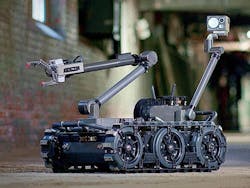Army chooses Teledyne FLIR for remotely operated bomb-disposal robots to find and destroy hidden explosives
WARREN, Mich. – U.S. Army unmanned ground vehicle (UGV) experts needed a medium-sized bomb-disposal robot able to detect, confirm, identify, and dispose of concealed explosives. They found their solution from the Teledyne FLIR LLC Unmanned Ground Systems (UGS) segment in Chelmsford, Mass.
Officials of the Army Contracting Command-Detroit Arsenal in Warren, Mich., announced a $10.3 million contract to Teledyne FLIR in September to build the Man Transportable Robot System Increment II (MTRS Inc II) -- a remotely operated unmanned ground vehicle (UGV) that can find and destroy hidden explosives while keeping human operators at safe distances.
The MTRS Inc II explosives-detection system has a standard chassis and modular mission payloads to support Army engineers; chemical, biological, radiological and nuclear (CBRN) soldiers; and special operations forces.
The MTRS Inc II provides remote standoff ability to locate, identify, and clear land mines, unexploded ordnance, and improvised explosive devices (IEDs) in the path of maneuvering Army or joint forces. It also enables CBRN Soldiers to employ CBRN sensors from a safe distance.
The unmanned ground vehicle replaces the aging non-standard fleet of robots with enhanced capabilities to clear obstacles and threats. The MTRS Inc II is part of the Army’s common modernized unmanned ground vehicles fleet, which consists of the MTRS Inc II, Common Robotic System-Individual (CRS-I), and the Common Robotic System-Heavy (CRS-H).
The MTRS Inc. II has a handheld controller that gives the operator a standoff capability to operate from on foot or from inside a vehicle; uses common hardware and software interfaces to enable a plug-and-play payload concept; and supports several different payloads.
The system also has optics within its HD camera with pan, tilt, and zoom features to identify hazards; a five-degree-of-freedom manipulator arm that pivots 360 degrees; and a wrist joint that enables the vehicle's gripper and camera to look over and down onto elevated surfaces.
On this contract Teledyne FLIR will do the work in Elkridge, Okla., and should be finished by April 2025. For more information contact Teledyne FLIR Unmanned Ground Systems online at www.flir.com/uis/ugs, or the Army Contracting Command-Detroit Arsenal at https://acc.army.mil/contractingcenters/acc-dta/.
About the Author
John Keller
Editor-in-Chief
John Keller is the Editor-in-Chief, Military & Aerospace Electronics Magazine--provides extensive coverage and analysis of enabling electronics and optoelectronic technologies in military, space and commercial aviation applications. John has been a member of the Military & Aerospace Electronics staff since 1989 and chief editor since 1995.
